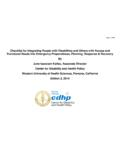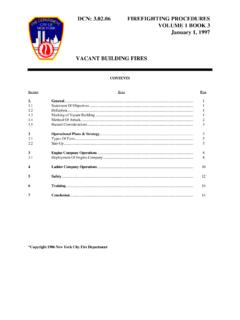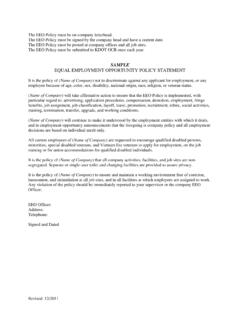Transcription of PI Module 4 Infection Control Dec06 - who.int
1 Pandemic influenza preparedness and mitigation in refugee and displaced populations. WHO training modules for humanitarian agencies. Module 4 - Infection prevention and Control 1 Module 4 : Infection prevention and Control Title Infection prevention and Control Responsible/facilitators Agency medical coordinator General Objective To delay or interrupt the transmission of influenza Specific Objectives Understand how to prevent Infection in health facilities and in the home Understand specific measures to take for patients, caregivers, health and other essential staff Understand that a risk assessment must be performed to determine PPE usage Practise the use and disposal of gloves and masks Practise hand washing Understand how to manage waste and how to handle the deceased Methodology Presentation: Power point or printed in A3 (laminated).
2 THIS Module REQUIRES DEMONSTRATION. Instructions for facilitators Included in body of Module Messages to retain Social distancing / Separation Respiratory etiquette Hand hygiene PPE according to risk assessment Contents See text Documents Power point or printed in A3 presentation Bibliography none Duration = 2 hours 30 minutes Pandemic influenza preparedness and mitigation in refugee and displaced populations. WHO training modules for humanitarian agencies.
3 Module 4 - Infection prevention and Control 2 Hand washing and use of PPE cannot solely be explained, they have to be demonstrated. Prepare water, soap, alcohol rub, masks, respirators and so on. Make sure you know how to use them before and read if necessary. Details explanation can be found in WHO documents such as the interim Infection Control guidelines, available at or SLIDE 1 Pandemic influenza training modules for humanitarian agenciesModule 4: Infection prevention and control1|Pandemic influenza preparedness and mitigation in refugee and displaced populationsWHO training modules for humanitarian agenciesModule 4 Infection prevention and controlPandemic influenza preparedness and mitigation in refugee and displaced populationsWHO training modules for humanitarian agenciesModule 4 Infection prevention and Control SLIDE 2 Pandemic influenza training modules for humanitarian agenciesModule 4.
4 Infection prevention and control2|ObjectivesObjectiveszUnderstand how to prevent Infection in health facilities and in the homezUnderstand specific measures to take for patients, caregivers, health and other essential staffzUnderstand that a risk assessment must be performed to determinePPE usagezPractise the use and disposal of gloves and maskszPractise hand washingzUnderstand how to manage waste and how to handle the deceased Pandemic influenza preparedness and mitigation in refugee and displaced populations. WHO training modules for humanitarian agencies. Module 4 - Infection prevention and Control 3 SLIDE 3 Pandemic influenza training modules for humanitarian agenciesModule 4: Infection prevention and control3|Actions to prevent infectionActions to prevent coughs and sneezes (everyone, always) / separation(everyone, always) hygiene (everyone, always) protective equipment (PPE) for essential staff(according to risk assessment ie what procedures or duties you are doing)Note.
5 PPE = masks/gloves/goggles As the majority of transmission occurs when infected people come into close contact with others, the 3 main measures recommended generally are : Social distancing /separation of AT LEAST 1m between people/ separation of well and sick individuals Cough/respiratory etiquette Wear masks if available. Sneeze/cough into your sleeve or cover with tissue or scarf or mask. If you have coughed/sneezed into your hands, wash hands immediately with soap and water. Hand washing Before eating or feeding others, after coughing/sneezing, after touching patients or their bed sheets, clothes and utensils, before and after preparing food, after going to the toilet, after removing masks or gloves.
6 In some instances, depending on the risk, PPE (personal protective equipment) such as masks or eye protection must be worn. This will be discussed influenza preparedness and mitigation in refugee and displaced populations. WHO training modules for humanitarian agencies. Module 4 - Infection prevention and Control 4 SLIDE 4 Pandemic influenza training modules for humanitarian agenciesModule 4: Infection prevention and control4|Risk assessmentRisk assessmentzRemember transmission of influenza increases if there contact(usually proximity < 1 metre) contact(with infected patients then self contamination) contact(with surfaces/objects contaminated with virus then self contamination) aerosol generating procedure(endotracheal intubation, suctioning, nasopharyngeal aspiration/swabbing)zA risk assessmenthelps determine what measuresshould be used and whento use them Pandemic influenza preparedness and mitigation in refugee and displaced populations.
7 WHO training modules for humanitarian agencies. Module 4 - Infection prevention and Control 5 SLIDE 5 Pandemic influenza training modules for humanitarian agenciesModule 4: Infection prevention and control5| Control at the sourceControl at the sourcezThe first priorityis Control at the sourceof Infection the patientzA patient should cover mouth and nose, if possible with a mask or scarf, when in close contactwith other peoplezDuring a pandemic, give a surgical or procedure maskto all patientspresenting to health facilities withfever/acute respiratory symptoms(cough or shortness of breath) Masks do not need to be used by patients when they are alone!
8 Wearing a mask all day long is difficult and the mask gets wet. The main priority is to Control the Infection at its source - the patient. If the patient's cough/sneeze is covered, they will not transmit it to others. When a sick individual coughs or sneezes, they must cover their mouth and nose with a mask or paper tissue or cloth or cough/sneeze into their sleeves to prevent infectious respiratory droplets from being inhaled by others who are near them, thereby transmitting the Infection to them. The next priority is to protect care givers and health care staff as they are frequently in close contact with sick patients and thus have a much higher risk of getting infected.
9 Pandemic influenza preparedness and mitigation in refugee and displaced populations. WHO training modules for humanitarian agencies. Module 4 - Infection prevention and Control 6 SLIDE 6 Pandemic influenza training modules for humanitarian agenciesModule 4: Infection prevention and control6|Distancing/separationDistancing /separationzIn the home, distance/separate the sick person from those who are well as much as possible (more details on Infection prevention at home on slides 7-8)zIn health facilities, separate patients with respiratory symptoms from others Ensure separate waiting areasfor patients with respiratory symptoms identify those with fever/acute respiratory symptoms (cough or shortness of breath)
10 Beforethey enter waiting rooms to separate them from patients with other symptoms Maximise distance between beds (more details on Infection prevention in health facilities on slide 9-18) SLIDE 7 Pandemic influenza training modules for humanitarian agenciesModule 4: Infection prevention and control7|Preventing Infection at home (What the ill person should do)Preventing Infection at home (What the ill person should do)zThe patientshould: Cover mouth and nose, if possible with a tightly-fitting mask or scarf, when in close contactwith other people distance/separate themselves from those who are well as much as possible Avoid close contact with uninfected people forat least 7 daysafter the beginning of flu symptoms Ensure proper hand hygiene Pandemic influenza preparedness and mitigation in refugee and displaced populations.
















